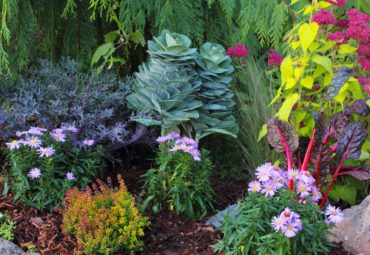
Consider the leaf as the breath of life, for without plant foliage, there would be no life. The most important living components on Earth contain life-giving chlorophyll. Every breath humans take is possible because chlorophyll synthesizes the energy of the sun, water and carbon dioxide.
The next time you select a plant for its great foliage, imagine that each leaf on Earth contains a thousand green chlorophyll machines, and that you hear the hum of photosynthesis going on inside each one. Plant a tree, or shrub or perennial for great fall foliage, and realize the reality is, it sustains the living world.
Chlorophyll may sustain the world but it’s the lack of it that provides the true leaf color and extraordinary fall displays. When the weather turns cool, many people think that is what triggers the leaves to turn color. Yet temperature, not timing, plays a small part in how intense the color will be. The best leaf color is during the years when there is adequate rainfall during the growing season, followed by dry fall conditions, coupled with warm days and cool nights.
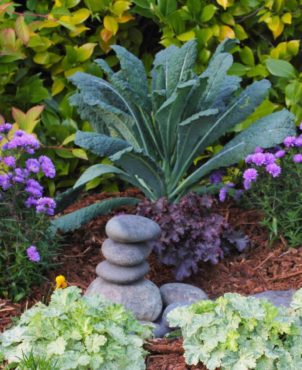
When the nights turn long and the days grow short, a corky layer of cells slowly block carbohydrates from moving from the leaves into the branches, and the minerals from moving from the roots into the leaves. When this happens, the chlorophyll shuts down and finally disappears. The chlorophyll keeps the leaves green during the growing season and masks the yellow and orange pigments, respectively called xanthophyll and carotenoid. Trees get their red and purple fall color from anthocyanins — manufactured in autumn from sugars trapped in a leaf.
Frost, heavy wind and rain can cause the leaves to drop before they reach their impending full color. In the Northwest, gardeners are lucky to have conditions favoring a bright autumn display most years. Contrary to popular belief, frost does not cause the leaves to turn color. Frost destroys autumn color if it’s too early in the season. Fortunately, the typical first frost dates happen after leaf fall in West Sound.
Gardeners often plant maple trees for fall color, turning the neighborhoods ablaze with scarlet, gold, apricots and yellow. Selecting plants with great foliage for the garden really enhances the space; however, the spectacular finale to the growing season comes not only from vibrant fall foliage, but includes evergreen and other types of foliage to add additional excitement to the garden.
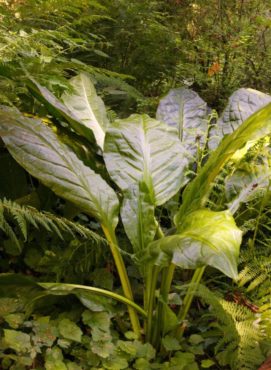
In the local climate, the Japanese maples (Acer palmatum, Acer shirasawanum and Acer japonicum) are the most popular because the trees are beautiful in almost every season. Many cultivars are sought out for their outstanding, ever-changing spring, summer and fall color.
Yet here comes autumn, with flora decked out for a last hurrah. Ah, but there is another side to plants this season — plants with fantastic hues of the rainbow waiting for gardeners to plant them in a design to knock the wind out of Mother Nature’s sails. It is time for her to come around to a beautiful fall garden instead of paying too much attention to her first child — spring. Fall is to jewel tones what spring is to pastels.
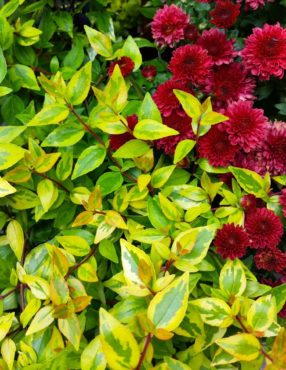
The season is not for washed-out or toned-down colors. It is a rainbow palette of brilliant reds, sunshine yellow and rich purples. Fall is the typical middle child vying for attention. The color says, “Hey, it’s autumn — look at me, look at me!”
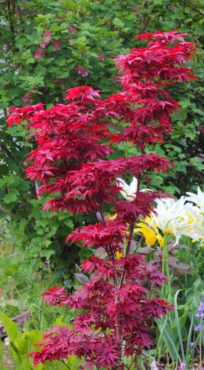
The columnar Twombly’s Red Sentinel Japanese maple (Acer palmatum ‘Twombly’s Red Sentinel’) fits into tight spaces. The maple slowly reaches 10-15 feet tall and 6-8 feet wide. The foliage emerges bright red in the spring and darkens as the season progresses. In autumn, the leaves turn a brilliant scarlet. To top off the tree’s spectacular foliage after the leaves fall, the bare stems are an attention-grabbing red in winter. This was a sport of another maple — Bloodgood Japanese maple (Acer palmatum var. atropurpureum ‘Bloodgood’), which also makes a fine small specimen tree with striking leaves all growing season and interesting bark for the winter.
Consider the glossy leaves of a heartwarming charmer Abelia ‘Kaleidoscope.’ Red stems hold chartreuse leaves with green centers. Abelia’s exceptional foliage shines through every season. However, when the weather cools down, hues of peach to burgundy creep into the evergreen leaves. In containers for fall and winter, the shrub, when combined with heucheras, grasses, kales and other great foliage plants, carries on like it’s a party in summer.
Fall is known for the popular flowering cabbage. But leafy vegetables — specifically, kale and Swiss chard — are outstanding leafy plants that you can eat. ‘Bright Lights,’ a kale bred in New Zealand, is a kaleidoscope of bright stems and leafy greens. Grown as a fall-to-late winter plant, it has bright white, neon orange, brilliant yellow or brazen red stems and green, red to burgundy leaves.
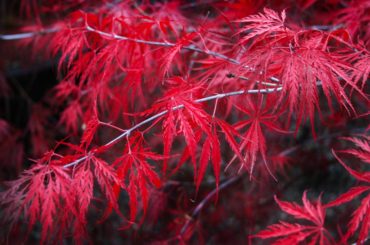
If the snow comes, the weight would bend the leaves down until they are completely smothered in white. Peeking above the snow would be brilliant, curled circles of stems in a white landscape. When the snow melts, the leaves pop back up, dust themselves off and continue showing themselves off. That’s when you ask yourself, why haven’t I grown these before? ‘Rainbow’ is a popular mix of varieties of Swiss chard. Make no mistake, you can have a gorgeous ornamental plant with these and eat them, too.
Kale can also be a highly decorative leaf in the garden. The best foliage for an almost tropical effect is Tuscan kale, with other common names such as black Tuscan, Tuscan cabbage, Italian kale, dinosaur kale, black kale and palm tree kale. Grown for its highly nutritious leaves, this leafy edible should be a mainstay in your fall to winter garden or container gardens.
In pristine native areas, if you come across foliage that is so large, it looks like a tropical ti leaf (Cordyline), chances are you are looking at the native skunk cabbage (Lysichiton americanus). Before turning up your nose, consider that this plant has the largest leaves of all the native plants in the Pacific Northwest.
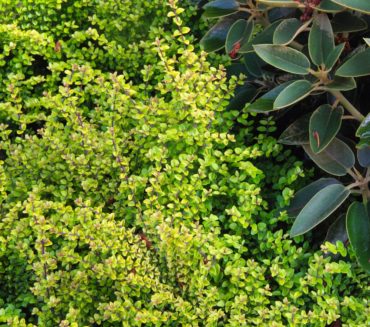
It grows in the shade and in a wet, moist spot, for a large leaf presence during the growing season. It’s a pleasant surprise for anyone to find out this plant is local and a pronounced choice for shady, moist spaces. If cut or bruised, the leaves help you quickly remember one of the reasons they call it skunk cabbage.
Moving from the extravagant large leaves, it’s time to consider a diminutive leaf shrub — a honeysuckle named Lonicera ‘Twiggy.’ This evergreen shrub may be short, with tiny leaves, yet it doesn’t just grow low to the ground. In fall, the leaves take on burnt-orange and red tints. Its form adds fine textural interest next to the larger leaves in the autumn garden.
This is a small sampling of fantastic foliage. With an abundance of great foliage that shows off its true colors this fall, it’s easy to consider the life-sustaining leaves in your garden. This fall, take a deep breath, remembering every inhale is possible because leaves are the breath of life. Then plant some more!





























